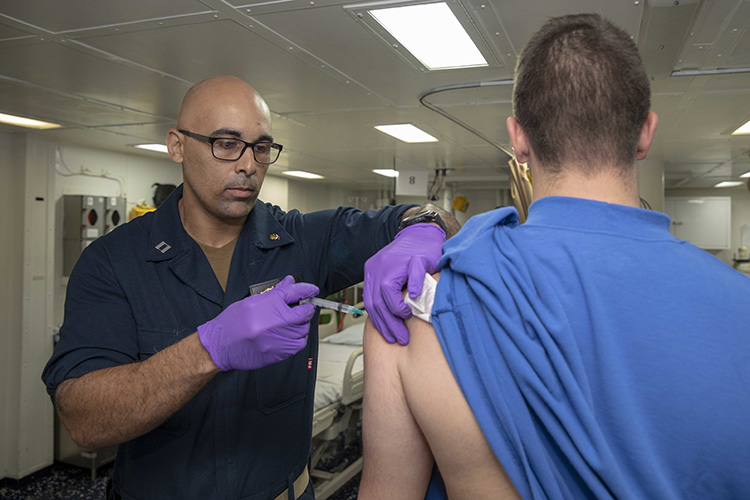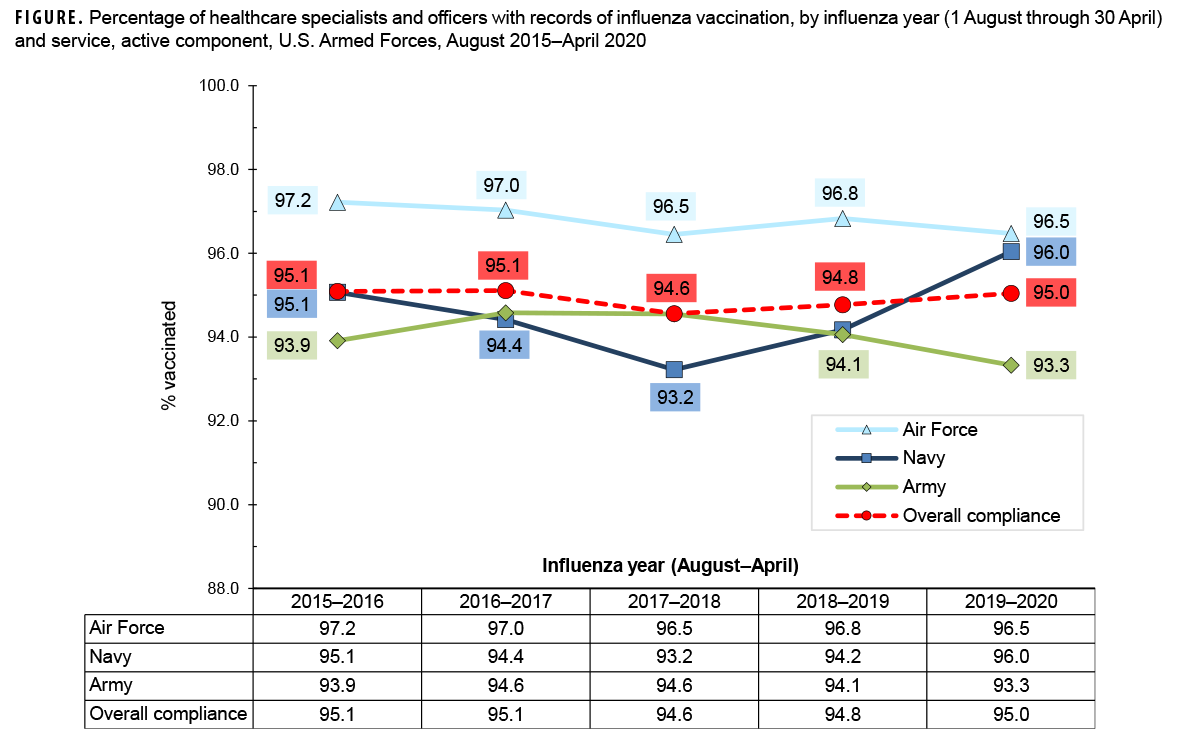Surveillance Snapshot: Influenza Immunization Among U.S. Armed Forces Healthcare Workers, August 2015–April 2020
 NORFOLK (Oct. 15, 2019) Lt. Sipriano Marte administers an influenza vaccination to Airman Tyler French in the intensive care unit aboard the Wasp-class amphibious assault ship USS Kearsarge (LHD 3). Kearsarge is underway conducting routine training. (U.S. Navy photo by Mass Communication Specialist Petty Officer 3rd Class Jacob Vermeulen/Released)
NORFOLK (Oct. 15, 2019) Lt. Sipriano Marte administers an influenza vaccination to Airman Tyler French in the intensive care unit aboard the Wasp-class amphibious assault ship USS Kearsarge (LHD 3). Kearsarge is underway conducting routine training. (U.S. Navy photo by Mass Communication Specialist Petty Officer 3rd Class Jacob Vermeulen/Released)
10/1/2020
By:
Armed Forces Health Surveillance Branch Communications Team
The U.S. Advisory Committee on Immunization Practices recommends that all healthcare personnel be vaccinated against influenza to protect themselves and their patients.1 The Joint Commission’s standard on infection control emphasizes that individuals who are your infected with influenza virus are contagious to others before any signs or symptoms appear. The Joint Commission requires that healthcare organizations have influenza vaccination programs for practitioners and staff and that they work toward the goal of 90% receipt of influenza vaccine. Within the Department of Defense, seasonal influenza immunization is mandatory for all uniformed personnel and for healthcare personnel who provide direct patient care and is recommended for all others (excluding those who are medically exempt).2–4
This snapshot covers a 5-year surveillance period (August 2015–April 2020) and presents the documented percentage compliance with the influenza immunization requirement among active component healthcare personnel of the Army, Navy, and Air Force. During the 2019–2020 influenza season, each of the 3 services had compliance rates of 93.3% or higher among healthcare personnel (Figure). For all services together, the compliance rate was 95.0%, very similar to the rate from the previous year.
References
-
Centers for Disease Control and Prevention. Immunization of health-care personnel: recommendations of the Advisory Committee on Immunization Practices (ACIP). MMWR Recomm Rep. 2011;60(RR-7):1–45.
-
Headquarters, Departments of the Army, the Navy, the Air Force, and the Coast Guard. Army Regulation 40-562, BUMEDINST 6230.15B, AFI 48-110_IP, CG COMDTINST M6230.4G. Medical Services: Immunizations and Chemoprophylaxis for the Prevention of Infectious Diseases. 7 October 2013.
-
Assistant Secretary of Defense (Health Affairs). Policy for Mandatory Seasonal Influenza Immunization for Civilian Health Care Personnel Who Provide Direct Patient Care in Department of Defense Military Treatment Facilities. Health Affairs Policy 08-005. 4 April 2008.
-
Assistant Secretary of Defense (Health Affairs). Addition of Pandemic Influenza Vaccine or Novel Influenza Vaccine to the Policy for Mandatory Seasonal Influenza Immunization for Civilian Health Care Personnel Who Provide Direct Patient Care in Department of Defense Military Treatment Facilities. Health Affairs Policy 11-010. 28 July 2011.

You also may be interested in...
Article
Jun 1, 2022
In 2021, mental health disorders accounted for the largest proportions of the morbidity and health care burdens that affected the pediatric and younger adult beneficiary age groups. Among adults aged 45–64 and those aged 65 or older, musculoskeletal diseases accounted for the most morbidity and health care burdens. As in previous years, this report ...
Article
Jun 1, 2022
In 2021, as in prior years, the medical conditions associated with the most medical encounters, the largest number of affected service members, and the greatest number of hospital days were in the major categories of injuries, musculoskeletal disorders, and mental health disorders. Despite the pandemic, COVID-19 accounted for less than 2% of total ...
Article
Jun 1, 2022
The hospitalization rate in 2021 was 48.0 per 1,000 person-years (p-yrs), the second lowest rate of the most recent 10 years. For hospitalizations limited to military facilities, the rate in 2021 was the lowest for the entire period. As in prior years, the majority (71.2%) of hospitalizations were associated with diagnoses in the categories of mental ...
Article
Jun 1, 2022
The proportions of evacuations out of USCENTCOM that were due to battle injuries declined substantially in 2021. For USCENTCOM, evacuations for mental health disorders were the most common, followed by non-battle injury and poisoning, and signs, symptoms, and ill-defined conditions. For USAFRICOM, evacuations for non-battle injury and poisoning were ...
Article
Jun 1, 2022
In 2021, the overall numbers and rates of active component service member ambulatory care visits were the highest of any of the last 10 years. Most categories of illness and injury showed modest increases in numbers and rates. The proportions of ambulatory care visits that were accomplished via telehealth encounters fell to under 15% in 2021, compared ...
Article
Jun 1, 2022
Surveillance snapshot: Illness and injury burdens, recruit trainees, U.S. Armed Forces, 2021
Article
May 1, 2022
Data from surveys may be used to make public health decisions at both the installation and the Department of the Army level. This study demonstrates that a vast majority of soldiers were likely sufficiently engaged and answered both bogus items correctly. Future surveys should continue to investigate careless responding to ensure data quality in ...
Article
May 1, 2022
This report summarizes incidence rates of the 5 most common sexually transmitted infections (STIs) among active component service members of the U.S. Armed Forces during 2013–2021. In general, compared to their respective counterparts, younger service members, non-Hispanic Black service members, those who were single and other/unknown marital status, ...
Article
May 1, 2022
Tick-borne Encephalitis in Military Health System Beneficiaries, 2012–2021. Tick-borne encephalitis (TBE) is a viral infection of the central nervous system that is transmitted by the bite of infected ticks, mostly found in wooded habitats in parts of Europe and Asia
Article
May 1, 2022
This is the first evaluation of ICD-10-CM-based cased definitions for COVID-19 surveillance among DOD health care beneficiaries. The 3 case definitions ranged from highly specific to a lower specificity, but improved balance between sensitivity and specificity.
Article
Apr 1, 2022
Exertional (or exercise-associated) hyponatremia refers to a low serum, plasma, or blood sodium concentration (below 135 mEq/L) that develops during or up to 24 hours following prolonged physical activity. Acute hyponatremia creates an osmotic imbalance between fluids outside and inside of cells.
Article
Apr 1, 2022
Exertional heat illness (hereafter referred to as heat illness) spans a spectrum from relatively mild conditions such as heat cramps and heat exhaustion, to more serious and potentially life-threatening conditions such as heat injury and exertional heat stroke (hereafter heat stroke).
Article
Apr 1, 2022
Exertional rhabdomyolysis is a potentially serious condition that requires a vigilant and aggressive approach. Some service members who experience exertional rhabdomyolysis may be at risk for recurrences, which may limit their military effectiveness and potentially predispose them to serious injury.
Article
Apr 1, 2022
From 2020 to 2021, the rate of incident heat stroke was relatively stable while the rate of heat exhaustion increased slightly
Article
Mar 1, 2022
Osteoarthritis (OA) is the most common adult joint disease and predominantly involves the weight-bearing joints. This condition, including spondylosis (OA of the spine), results in significant disability and resource utilization and is a leading cause of medical separation from military service.
You are leaving Health.mil
The appearance of hyperlinks does not constitute endorsement by the Department of Defense of non-U.S. Government sites or the information, products, or services contained therein. Although the Defense Health Agency may or may not use these sites as additional distribution channels for Department of Defense information, it does not exercise editorial control over all of the information that you may find at these locations. Such links are provided consistent with the stated purpose of this website.
You are leaving Health.mil
View the external links disclaimer.
Last Updated: July 11, 2023